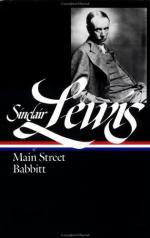She rented the second floor of the city hall for two months. All through the spring the association thrilled to its own talent in that dismal room. They cleared out the bunting, ballot-boxes, handbills, legless chairs. They attacked the stage. It was a simple-minded stage. It was raised above the floor, and it did have a movable curtain, painted with the advertisement of a druggist dead these ten years, but otherwise it might not have been recognized as a stage. There were two dressing-rooms, one for men, one for women, on either side. The dressing-room doors were also the stage-entrances, opening from the house, and many a citizen of Gopher Prairie had for his first glimpse of romance the bare shoulders of the leading woman.
There were three sets of scenery: a woodland, a Poor Interior, and a Rich Interior, the last also useful for railway stations, offices, and as a background for the Swedish Quartette from Chicago. There were three gradations of lighting: full on, half on, and entirely off.
This was the only theater in Gopher Prairie. It was known as the “op’ra house.” Once, strolling companies had used it for performances of “The Two Orphans,” and “Nellie the Beautiful Cloak Model,” and “Othello” with specialties between acts, but now the motion-pictures had ousted the gipsy drama.
Carol intended to be furiously modern in constructing the office-set, the drawing-room for Mr. Grimm, and the Humble Home near Kankakee. It was the first time that any one in Gopher Prairie had been so revolutionary as to use enclosed scenes with continuous side-walls. The rooms in the op’ra house sets had separate wing-pieces for sides, which simplified dramaturgy, as the villain could always get out of the hero’s way by walking out through the wall.
The inhabitants of the Humble Home were supposed to be amiable and intelligent. Carol planned for them a simple set with warm color. She could see the beginning of the play: all dark save the high settles and the solid wooden table between them, which were to be illuminated by a ray from offstage. The high light was a polished copper pot filled with primroses. Less clearly she sketched the Grimm drawing-room as a series of cool high white arches.
As to how she was to produce these effects she had no notion.
She discovered that, despite the enthusiastic young writers, the drama was not half so native and close to the soil as motor cars and telephones. She discovered that simple arts require sophisticated training. She discovered that to produce one perfect stage-picture would be as difficult as to turn all of Gopher Prairie into a Georgian garden.
She read all she could find regarding staging, she bought paint and light wood; she borrowed furniture and drapes unscrupulously; she made Kennicott turn carpenter. She collided with the problem of lighting. Against the protest of Kennicott and Vida she mortgaged the association by sending to Minneapolis for a baby spotlight, a strip light, a dimming device, and blue and amber bulbs; and with the gloating rapture of a born painter first turned loose among colors, she spent absorbed evenings in grouping, dimming-painting with lights.




